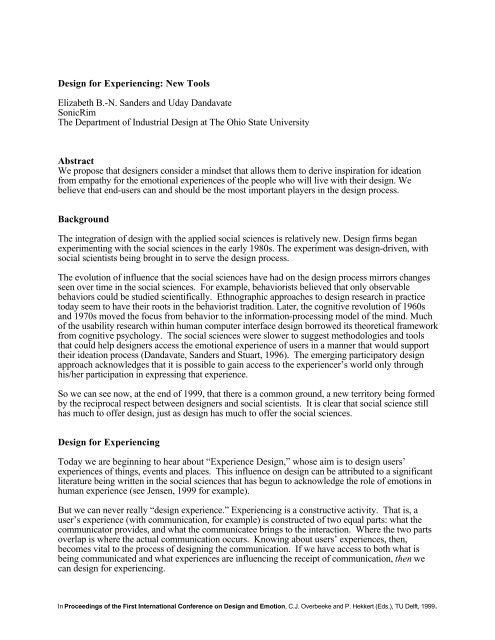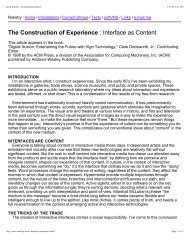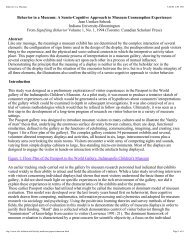Design for Experiencing: New Tools Elizabeth B.-N ... - ec(h)o
Design for Experiencing: New Tools Elizabeth B.-N ... - ec(h)o
Design for Experiencing: New Tools Elizabeth B.-N ... - ec(h)o
You also want an ePaper? Increase the reach of your titles
YUMPU automatically turns print PDFs into web optimized ePapers that Google loves.
<strong>Design</strong> <strong>for</strong> <strong>Experiencing</strong>: <strong>New</strong> <strong>Tools</strong><strong>Elizabeth</strong> B.-N. Sanders and Uday DandavateSonicRimThe Department of Industrial <strong>Design</strong> at The Ohio State UniversityAbstractWe propose that designers consider a mindset that allows them to derive inspiration <strong>for</strong> ideationfrom empathy <strong>for</strong> the emotional experiences of the people who will live with their design. Webelieve that end-users can and should be the most important players in the design process.BackgroundThe integration of design with the applied social sciences is relatively new. <strong>Design</strong> firms beganexperimenting with the social sciences in the early 1980s. The experiment was design-driven, withsocial scientists being brought in to serve the design process.The evolution of influence that the social sciences have had on the design process mirrors changesseen over time in the social sciences. For example, behaviorists believed that only observablebehaviors could be studied scientifically. Ethnographic approaches to design research in practicetoday seem to have their roots in the behaviorist tradition. Later, the cognitive revolution of 1960sand 1970s moved the focus from behavior to the in<strong>for</strong>mation-processing model of the mind. Muchof the usability research within human computer interface design borrowed its theoretical frameworkfrom cognitive psychology. The social sciences were slower to suggest methodologies and toolsthat could help designers access the emotional experience of users in a manner that would supporttheir ideation process (Dandavate, Sanders and Stuart, 1996). The emerging participatory designapproach acknowledges that it is possible to gain access to the experiencer’s world only throughhis/her participation in expressing that experience.So we can see now, at the end of 1999, that there is a common ground, a new territory being <strong>for</strong>medby the r<strong>ec</strong>iprocal resp<strong>ec</strong>t between designers and social scientists. It is clear that social science stillhas much to offer design, just as design has much to offer the social sciences.<strong>Design</strong> <strong>for</strong> <strong>Experiencing</strong>Today we are beginning to hear about “Experience <strong>Design</strong>,” whose aim is to design users’experiences of things, events and places. This influence on design can be attributed to a significantliterature being written in the social sciences that has begun to acknowledge the role of emotions inhuman experience (see Jensen, 1999 <strong>for</strong> example).But we can never really “design experience.” <strong>Experiencing</strong> is a constructive activity. That is, auser’s experience (with communication, <strong>for</strong> example) is constructed of two equal parts: what th<strong>ec</strong>ommunicator provides, and what the communicatee brings to the interaction. Where the two partsoverlap is where the actual communication occurs. Knowing about users’ experiences, then,b<strong>ec</strong>omes vital to the process of designing the communication. If we have access to both what isbeing communicated and what experiences are influencing the r<strong>ec</strong>eipt of communication, then w<strong>ec</strong>an design <strong>for</strong> experiencing.In Proceedings of the First International Conference on <strong>Design</strong> and Emotion, C.J. Overbeeke and P. Hekkert (Eds.), TU Delft, 1999.
In fact, if we can learn to access people’s experiences (past, current and potential), then we can makeuser experience the source of inspiration and ideation <strong>for</strong> design. And by making user experiencethe source of inspiration, we are better able to design <strong>for</strong> experiencing.How Do We Access Experience?There are many ways we can learn from people about their memories, their current experiences andtheir ideal experiences:We can listen to what people say.We can interpret what people express, and make inferences about what they think.We can watch what people do.We can observe what people use.We can uncover what people know.We can reach toward understanding what people feel.We can appr<strong>ec</strong>iate what people dream.Each route to experience reveals a different story or picture. Listening to what people say tells uswhat they are able to express in words (i.e., explicit knowledge). But it only gives us what they wantus to hear. Watching what people do and seeing what they use provides us with observablein<strong>for</strong>mation (or observed experience). But knowing what people say/think, do and use is not enough(Sanders, 1992).Discovering what people think and know provides us with their perceptions of experience.Understanding how people feel gives us the ability to empathize with them. This way of knowingprovides tacit knowledge, i.e., knowledge that can’t readily be expressed in words (Polanyi, 1983).Seeing and appr<strong>ec</strong>iating what people dream shows us how their future could change <strong>for</strong> the better.It is another <strong>for</strong>m of tacit knowledge that can reveal latent needs, i.e., needs not r<strong>ec</strong>ognizable untilthe future. For example, the Internet has been revealing many previously latent communicationneeds.The ability to not just know, but also to empathize with the user comes only at the deepest levels oftheir expression. By accessing people’s feelings, dreams and imaginations, we can establishresonance with them. Sp<strong>ec</strong>ial tools are needed to access the deeper levels of user expression.In Proceedings of the First International Conference on <strong>Design</strong> and Emotion, C.J. Overbeeke and P. Hekkert (Eds.), TU Delft, 1999.
Accessing Experience: What People Do, Say and MakeThe different ways of accessing experience have evolved over time. Traditional design researchmethods were focused primarily on observational research (i.e., looking at what people do and use).Traditional market research methods, on the other hand, have been focused more on what people sayand think (through focus groups, interviews, and questionnaires). The new tools are focused onwhat people make, i.e., what they create from the toolkits we provide <strong>for</strong> them to use in expressingtheir thoughts, feelings and dreams. Many of these tools are based on non-verbal modes ofexpression.When all three persp<strong>ec</strong>tives (what people do, what they say, and what they make) are exploredsimultaneously, one can more readily understand and establish empathy with the people who useproducts and in<strong>for</strong>mation systems.The Make <strong>Tools</strong>The Make <strong>Tools</strong> are the most r<strong>ec</strong>ent development in design research. B<strong>ec</strong>ause they are primarilyvisual, the Make <strong>Tools</strong> serve as a common ground <strong>for</strong> conn<strong>ec</strong>ting the thoughts and ideas of peoplefrom different disciplines and persp<strong>ec</strong>tives. The Make <strong>Tools</strong> are b<strong>ec</strong>oming a new language <strong>for</strong> codesign.They have been found to facilitate exchange between the people who experience products,interfaces, systems and spaces and the people who design <strong>for</strong> experiencing. The Make <strong>Tools</strong> are a“design language” <strong>for</strong> users, not just <strong>for</strong> designers; a design language built upon an aesthetics ofexperience rather than an aesthetics of <strong>for</strong>m.B<strong>ec</strong>ause they are proj<strong>ec</strong>tive, the Make <strong>Tools</strong> are particularly good in the generative phase of thedesign development process. Generative research occurs very early in the design developmentprocess. Its purpose is to discover as-yet unknown, undefined, and/or unanticipated user orconsumer needs. It is in the generative phase that we are looking <strong>for</strong> ideas and opportunities to fillunmet user needs. Ideas and opportunities generated by users are usually quite relevant andpowerful when acted upon and brought to market.When Make <strong>Tools</strong> are used in the generative phase of the design development process, usergeneratedartifacts result. We have discovered that there are many different types of Make Toolkitsthat facilitate the expression of a wide range of artifacts and/or models. With “emotional toolkits,”people make artifacts such as collages or diaries that show or tell stories and dreams. Every artifacttells a story and so we typically ask the creator of the artifact to tell us that story. The storiesassociated with the artifacts from the emotional toolkits tell of feelings, dreams, fears, andaspirations. With “cognitive toolkits,” people make artifacts such as maps, mappings, 3-D modelsIn Proceedings of the First International Conference on <strong>Design</strong> and Emotion, C.J. Overbeeke and P. Hekkert (Eds.), TU Delft, 1999.
of functionality, diagrams of relationships, flowcharts of processes and cognitive models. Thestories associated with the artifacts from the cognitive toolkits tell us how people understand andmisunderstand things, events and places. The cognitive toolkits can also reveal the intuitiverelationships between system componentsBy knowing how to access people’s feelings and ideas, we are able to establish resonance between acompany and its customers. Resonating, or being in synch with one’s customers, means being ableto quickly respond to their changing needs and aspirations. Resonance can be achieved by invitingusers to play a role in the design development process.Coll<strong>ec</strong>tive GenerativityWe have found that the new tools are eff<strong>ec</strong>tive in accessing end-users’ and other people’s unspokenfeelings and ideas. The ideas they generate tend to be experience-based, not obj<strong>ec</strong>t-based. Thetools are proj<strong>ec</strong>tive in nature, allowing users to proj<strong>ec</strong>t their own needs and desires onto theirimagined experiences.The new tools can, in fact, harness the coll<strong>ec</strong>tive and infinitely expanding set of ideas andopportunities that emerge when the people who have a stake in the process are invited to “play thegame.” Generative methods are a new language that enables all the stakeholders to contributedir<strong>ec</strong>tly to the development of products, goods and services. This new language relies on visualliteracy and begins to bring it into balance with verbal literacy.Participatory CultureToday it’s not “business as usual” anymore. The rules have changed and continue to change. Thenew rules are the rules of networks, not hierarchies. People are cynical about the methods and goalsof consumerism. The users of products, interfaces, systems, and spaces are realizing that throughnetworking they have an enormous amount of coll<strong>ec</strong>tive influence. They are beginning to use theirinfluence to get what they want, when they want it and how they want it. The new rules call <strong>for</strong> newtools. People want to express themselves and to participate dir<strong>ec</strong>tly and proactively in the designdevelopment process.<strong>Design</strong> is ChangingHow does the emergence of the new tools change the nature of design education? <strong>Design</strong>ers needto be trained to go beyond the individualized expression of visual communication. They need tolearn how to b<strong>ec</strong>ome involved in the creation and construction of the new tools. <strong>Design</strong>ers andsocial scientists will need to work together in this regard. Social scientists bring frameworks <strong>for</strong> theunderstanding of user experience to the table, while designers know how to synthesize and embodyideas and opportunities.How does the emergence of the new tools change the role of the designer? The roles of designerand design researcher are b<strong>ec</strong>oming mutually interdependent. The roles are converging to the pointwhere they are blurring. <strong>Design</strong>ers will participate in the creation of the tools and in the expansionof the design language <strong>for</strong> users. <strong>Design</strong>ers will observe first-hand the experiences the tools af<strong>for</strong>d<strong>for</strong> creative expression by the users and other stakeholders. <strong>Design</strong>ers will be part of teamsresponsible <strong>for</strong> the analysis and interpretation of the “data”: the user-generated artifacts andmodels. Finally, designers can use the ideas generated by the users as sources of design inspirationand innovation.In Proceedings of the First International Conference on <strong>Design</strong> and Emotion, C.J. Overbeeke and P. Hekkert (Eds.), TU Delft, 1999.
References and Related ReadingsAdams, E. and Sanders, E.B.-N. (1995). An evaluation of the fun factor <strong>for</strong> the Microsoft Easy BallMouse. Proceedings of the Human Factors and Ergonomics Society, 39th Annual MeetingBarlow, J.P. (1994) “The Economy of Ideas.” Wired, March, 85.Dandavate, U., Sanders, E.B.-N. and Stuart, S. (1996). “Emotions Matter: User Empathy in theProduct Development Process.” Proceedings of the Human Factors and Ergonomics Society,40th Annual Meeting.Jensen, R. (1999) The Dream Society: How the Coming Shift from In<strong>for</strong>mation to Imaginationwill Trans<strong>for</strong>m your Business. <strong>New</strong> York: McGraw-Hill.Kelly, K. (1998) <strong>New</strong> Rules <strong>for</strong> the <strong>New</strong> Economy. <strong>New</strong> York: Viking.Krippendorff, K. (1996) “A Traj<strong>ec</strong>tory of Artificiality and <strong>New</strong> Principles of <strong>Design</strong>.”Unpublished manuscript.Leinbach, C.O. (1999) “About Cake and the Top Ten Things (more or less) Dorothy MustHave Been Thinking When She Said, “Toto, I’ve a Feeling We’re Not Industrial Anymore.”Unpublished manuscript.Pine, B.J. and Gilmore, J.H. (1999) The Experience Economy: Work is Theatre and Every Businessa Stage. Boston: Harvard Business School Press.Polanyi, M. (1983) The Tacit Dimension. Gloucester, MA: Peter Smith.Sanders, E.B.-N. (1992) “Converging Persp<strong>ec</strong>tives: Product Development Research <strong>for</strong> the1990s.” <strong>Design</strong> Management Journal, Fall.Sanders, E.B.-N. (1994). “But Is It Useful? Testing Beyond Usability.” Innovation, Spring.Sanders, L., Dandavate, U. and Stuart, S. (1996) “User Empathy in the Product DevelopmentProcess.” Proceedings of IDSA Conference on Alternate Realities, (on CD-ROM), IDSA, 1996.Sanders, L. (1997) Cognition and Emotion Bibliography. A proj<strong>ec</strong>t of the Graphic <strong>Design</strong>Education Association. American Center <strong>for</strong> <strong>Design</strong>, Chicago, Illinois.In Proceedings of the First International Conference on <strong>Design</strong> and Emotion, C.J. Overbeeke and P. Hekkert (Eds.), TU Delft, 1999.





